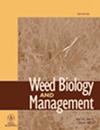Isolation, selection, and identification of phytopathogenic fungi with bioherbicide potential for the control of field bindweed (Convolvulus arvensis L.)
IF 1.5
4区 农林科学
Q3 AGRONOMY
引用次数: 0
Abstract
Abstract Field bindweed ( Convolvulus arvensis L.) has been described as one of the most noxious weeds in agricultural soils worldwide. Furthermore, its control by conventional herbicides can promote the emergence of resistant biotypes as well as negatively affect human health and the environment. An ecological alternative for weed management is the use of phytopathogenic fungi. In this study, 68 fungal strains were isolated from C. arvensis leaves exhibiting symptoms of fungal disease. Seven isolates were confirmed as pathogenic to C. arvensis in a detached leaf assay. Filtered cell‐free cultures (FCFC) of these seven isolates were then evaluated. FCFC of TV1 and ET4 showed the best results, inhibiting seedling dry weight by up to 48% in vivo and shoot dry weight up to 35% in growth chamber assays. Phytopathogenic evaluation of both isolates showed disease severity >67%, and an ability to inhibit root dry weight by up to 80%. Inhibitory effects were not observed on chickpea, bean, sorghum, maize, or tomato plants, suggesting pathogenic specificity of TV1 and ET4 to field bindweed. Molecular identification revealed a high similarity of TV1 (100% identity) with Macrophomina phaseolina , and a high similarity of ET4 with Alternaria alternata (99.8% identity). To the best of our knowledge, this is the first report of M. phaseolina showing pathogenicity against field bindweed worldwide, and the first report for A. alternata in Mexico. The results reveal that these fungi and/or their FCFC have the potential to be used as bioherbicidal agents against C. arvensis .具有生物除草剂潜力的野旋花植物病原真菌的分离、选择和鉴定
摘要田间旋花(Convolvulus arvensis L.)是世界范围内农业土壤中最有害的杂草之一。此外,常规除草剂对其控制会促进抗性生物型的出现,并对人类健康和环境产生负面影响。杂草管理的一个生态替代方案是使用植物病原真菌。本研究共分离到68株具有真菌病症状的紫檀叶片真菌。在离体叶片试验中,7株分离株被证实具有致病性。然后对这七个分离株的过滤无细胞培养物(FCFC)进行评估。TV1和ET4的ffcfc效果最好,在体内抑制幼苗干重达48%,在生长室试验中抑制茎干重达35%。两株菌株的植物致病性评估显示,病害严重程度为67%,根系干重抑制能力高达80%。在鹰嘴豆、豆类、高粱、玉米和番茄等植物上均未观察到抑制作用,表明TV1和ET4对田花的致病特异性。分子鉴定结果显示,TV1序列与菜绿巨蝇(Macrophomina phaseolina)的同源性为100%,ET4序列与alternnaria alternata的同源性为99.8%。据我们所知,这是世界范围内首次报道的菜绿芽孢杆菌对田间花蓟马具有致病性的报道,也是墨西哥首次报道的对野花蓟马具有致病性的报道。结果表明,这些真菌和/或它们的氟氯烃具有作为生物除草剂的潜力。
本文章由计算机程序翻译,如有差异,请以英文原文为准。
求助全文
约1分钟内获得全文
求助全文
来源期刊

Weed Biology and Management
农林科学-农艺学
CiteScore
2.70
自引率
0.00%
发文量
13
审稿时长
>36 weeks
期刊介绍:
Weed Biology and Management is an international journal, published four times per year. The journal accepts contributions in the form of original research and review articles in all aspects of weed science. Contributions from weed scientists in the Asia–Pacific region are particularly welcomed.
The content of the contributions may relate to weed taxonomy, ecology and physiology, weed management and control methodologies, herbicide behaviors in plants, soils and environment, utilization of weeds and other aspects of weed science. All contributions must be of sufficient quality to extend our knowledge in weed science.
 求助内容:
求助内容: 应助结果提醒方式:
应助结果提醒方式:


